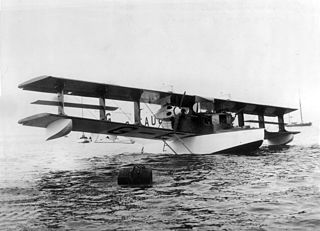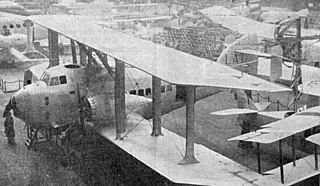Related Research Articles

The Saunders Kittiwake was a British amphibian flying-boat built by S. E. Saunders at East Cowes, Isle of Wight.

The Latécoère 4 was a three-engined, 15-passenger biplane built in France in the early 1920s. It proved difficult to fly and was discontinued, though a second machine was completed as the Latécoère 5 bomber.
The Spijker V.3, sometimes anglicized to Spyker V.3 or Spyker-Trompenburg V.3, was a Dutch single-engine, single-seat biplane fighter, designed and built just before the end of World War I.

The Albatros L.71 was a two-seat, single pusher engined biplane built in Germany in the 1920s.
The Caudron C.251 Et-2 was a French tandem seat, open cockpit biplane designed as an intermediate trainer and built in 1931. It did not go into production.

The Caudron C.140 was a French tandem cockpit sesquiplane designed in 1928 as a combination of liaison aircraft and observer and gunnery trainer.

The Caudron C.68 was a two-seat French training and touring aircraft, built in the early 1920s, which attracted interest at the time because of its simple and fast wing folding arrangement. Only a few were produced.

The Caudron C.43 was the first French five-engined aircraft, a biplane intended for passenger transport or military use and multi-engined for safety. A development of the three-engined Caudron C.39, it had one tractor configuration engine in the nose and two push-pull pairs between the wings. It was capable of carrying eight passengers but was not developed.
The Caudron C.37 was a French three-engined biplane passenger transport, built in 1920. It could carry six passengers.

The Caudron C.33 "Landaulet Monsieur-Madame" was a French twin engined biplane with four seats, two in open cockpits and two in an enclosed cabin.

The Caudron C.25 was a large, three-engined, biplane airliner, designed and built in France soon after the end of World War I. Its enclosed cabin could accommodate up to eighteen passengers.

The Heinkel HD 20 was a twin engine, three seat German biplane built in 1926 for civil survey work.

The Latham HB.5 was a French biplane flying boat with four engines in push-pull configuration pairs. Ten were used by the French Navy.
The Latham E-5 was a large French Naval four engine biplane flying boat, flown in 1925. It was successfully tested but only one was built.
The Latham L.1 was a French competitor in the 1923 Schneider Trophy race. It was a twin engine, biplane flying boat, built by Société Latham.
The Caproni Ca.61 was an Italian heavy day bomber aircraft of 1922. It was the final development of the Caproni three engine, twin boom biplane types developed during World War I, but it was not put into production.
The Potez 24 A.2 was a mid-1920s French biplane intended to replace the Potez 15 as an army observation aircraft. The further improved and larger Potez 25 was preferred for production.

The Lioré et Olivier Leo H-15 was a French twelve-seat civil flying boat, flown in a national contest in 1926. It did not win but set two load carrying records, one a world record.

The CAMS 54 was a strengthened and more powerful version of the French CAMS 51 civil transport and naval reconnaissance flying boat, developed for transatlantic flights. It is sometimes referred to as the 54 GR.
The LFG V 8 Bärbel (Barbel) in English) was a small, single-engined, biplane flying boat which carried two passengers. The sole example was built in Germany shortly after World War I but was exported and used for Baltic flights.
References
- 1 2 3 4 5 6 7 8 "L'hydravion Tri-moteur Latham". L'Aéronautique. 2 (18): 218–220. November 1920.
- 1 2 3 4 5 Bruno Parmentier (20 October 1998). "Latham Trimoteur" . Retrieved 12 January 2016.
- ↑ "L'aéronautique au jour le jour". L'Aéronautique. 2 (15): 136. August 1920.
- ↑ Bruno Parmentier (20 October 1998). "Latham HB-5" . Retrieved 7 January 2012.